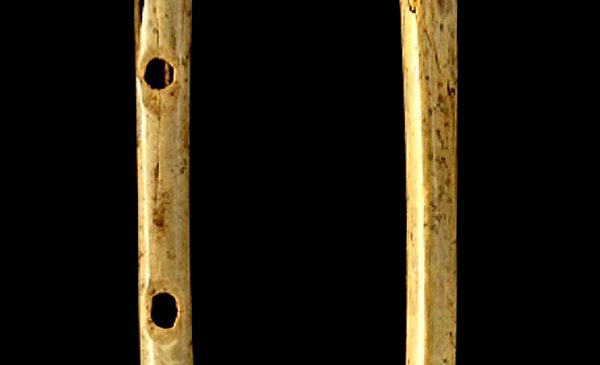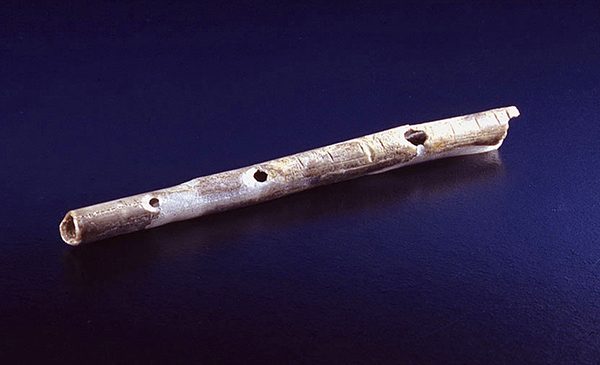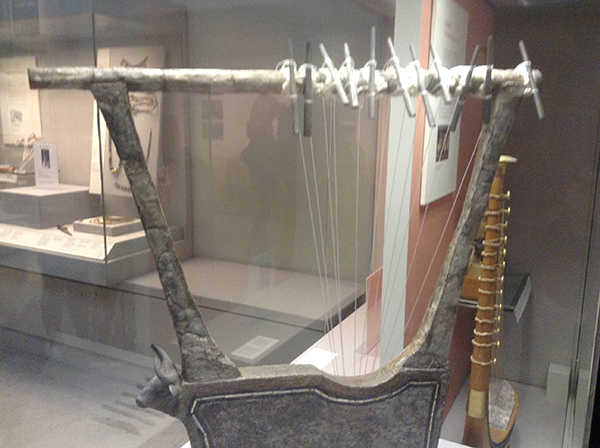By Michael Seifert and Youssef Kanjou
We know nothing about the beginning of music. In the traditional myths of the peoples, music is given to humans by the gods and used in cult rituals and incantations. The famous founder of the biological theory of evolution, Charles Darwin, put forward the theory that music originated as an imitation of animal sounds, especially bird calls. The ethnological study of the music of primitive peoples suggests that, before the use of instruments, music initially consisted of singing and drumming on objects and was associated with rhythmic dance.
The oldest preserved musical instruments created by humans are flutes made from bird bones with holes drilled in them. They have been excavated by Tübingen archaeologists in caves in the Swabian Alb in recent decades and are dated to an age of around 40,000 years on the basis of the layers found.
In 1995, the first excavated flute was assembled from 23 fragments of a swan wing bone. Eight flutes have since been found, including two carved from mammoth ivory.

Making them from ivory is extremely complex and requires a high degree of craftsmanship. “Different blowing techniques and ways of playing the instruments are possible, so that they could be used to produce very different timbres and melodies. As the flute fragments were found amidst the settlement remains, music was probably part of people’s everyday lives,” write the Tübingen archaeologists. Flute music was probably accompanied by singing, clapping and drumming—perhaps during rituals. The most complete instrument to date consists of twelve fragments of a griffon vulture bone. Overall, the flutes must have sounded very different, as they have different lengths and diameters. One of the caves has a large hall with exceptional acoustics; the music must have created a very special atmosphere there.
The first figurative works of art ever found by mankind also date from the same period and from the same caves: small animal figures carved from mammoth ivory.

Archaeologists can prove that the first development of symbolic culture in the form of art and music goes hand in hand with larger groups of nomadic people living together. This in turn led to an evolutionary advantage in the form of higher birth and survival rates and to the displacement and extinction of the Neanderthal species that had previously lived in Europe for over 150,000 years.
One of these oldest flutes can be seen, for example, in the University of Tübingen Museum at Hohentübingen Castle, while others can be found in the Prehistoric Museum in Blaubeuren near Ulm. The flautist Anna Friederike Potengowski is trying to reconstruct the music that Ice Age people might have played 40,000 years ago on flutes modeled on archaeological finds. Audio examples can be found here: Anna Friederike Potengowski – The Edge of Time (CD) – jpc and on streaming services.
In our journey through time, we now take a leap forward several decades and into the Middle East region. There are many musical instruments that archaeologists have unearthed in Mesopotamia, the land of Mesopotamia, the region of the earliest advanced civilizations. Perhaps the most important is the so-called “Lyre of Ur” from 2500 BC, which was discovered in the royal tomb of Ur in southern Iraq and is now in the British Museum in London. But what are the oldest notes and the oldest piece of music?Many ancient musical symbols have long been found on cuneiform tablets in the Middle East, but they were all incomplete fragments. In 1950, however, the oldest piece of music and the oldest song in the world seem to have been discovered. They were found in the city of Ugarit in Syria and date back to the late Bronze Age, around 1400 B.C. On the cuneiform tablet with the number A-6, which is about the size of a smartphone, there are two parts: The upper part with four lines in Hurrian is an ancient religious song, a hymn. It tells the story of a barren young girl. She believes that her bad behavior is the reason for her infertility, so the girl prays to Nikkal, the moon goddess, at night. She carries a small pewter jug with sesame seeds or sesame oil, which she offers as a sacrifice to the goddess.

The lower part of the tablet consists of seven lines in Akkadian. These contain a series of musical symbols and signs, but no words. These could be explanations for musicians on how to play the melody. Akkadian is an early Semitic language that belongs to the same language family as Arabic and Hebrew. The Hurrian language, on the other hand, is not related to any modern language.
This oldest document of musical notes to date was discovered in the archives of the royal palace of the city of Ugarit (modern name: Ras Shamra) on the Syrian coast near the city of Latakia. Ugarit was an ancient empire and metropolis in the 14th and 13th centuries BC, a gateway to trade with the coasts of the Mediterranean. The world’s first alphabet was also discovered in Ugarit, as well as one of the oldest libraries, in which literary, religious and scientific texts were found.
Scientists from different countries and disciplines such as archaeology, music and physics have been working for a long time to decipher the riddles of this cuneiform tablet. They then tried to translate it into music. The lute was chosen as the most suitable musical instrument for playing this melody and a lute was reconstructed based on a model found in ancient Ugarit.
The title of the first attempt to play this melody, which had been forgotten for more than 3000 years, was “Voices from the Silence”. It was undertaken by Raoul Gregory Vitale in Syria. Recently, the archaeologist Richard Dumbrill presented a modern interpretation and translation of the song and the sheet music in his book “The Impact of Musicology in the Ancient Near East”. In 2008, the Syrian musician Malik Jandali presented his vision of the original Ugarit compositions, which he arranged for piano and orchestra, on a CD entitled “Echoes of Ugarit”.
Here you can listen to how artists and scientists imagine the ancient music:
https://www.youtube.com/watch?v=tAc2KDNHEw4
https://www.youtube.com/watch?v=9c-hmFN610g&t=6s
https://www.youtube.com/watch?v=NeP_AS0DqaU&t=1s
https://www.youtube.com/watch?v=xSnLwLnOAf4
tun24021902
Die “Lyra von Ur” von 2500 v. Chr., die im königlichen Grab von Ur im Süden des Irak entdeckt wurde und sich heute im Britischen Museum befindet. Foto: tuenews INTERNATIONAL / Youssef Kanjou.
002318
002319
002320
002321




